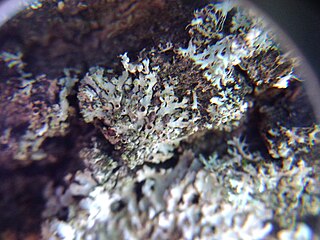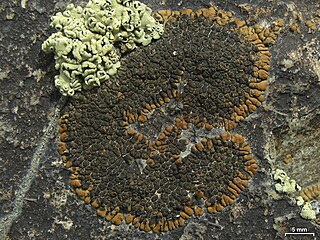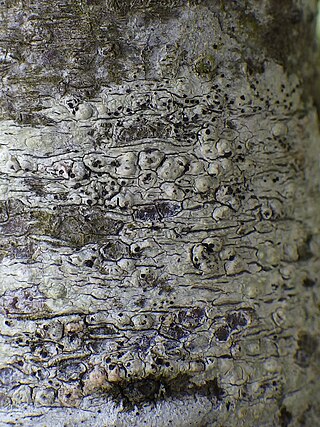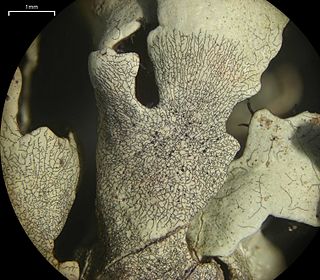
Lichenochora is a genus of fungi in the family Phyllachoraceae. It has 44 species. All species in the genus are lichenicolous, meaning they grow parasitically on lichens. The genus was circumscribed by Josef Hafellner in 1989, with Lichenochora thallina assigned as the type species.

Opegrapha is a genus of lichenized fungi in the family Opegraphaceae. Species include:

Stigmidium is a genus of lichenicolous (lichen-eating) fungi in the family Mycosphaerellaceae. The genus was circumscribed by Italian botanist Vittore Benedetto Antonio Trevisan de Saint-Léon in 1860, with Stigmidium schaereri assigned as the type species.

Sphaerellothecium is a genus of fungi in the family Phyllachoraceae. All of the species in the genus are lichenicolous, meaning they grow parasitically on lichens.

Muellerella is a genus of lichenicolous lichens in the family Verrucariaceae. The genus has a widespread distribution, especially in northern temperate areas, and contains species that live on other lichens, or on liverworts.
Merismatium is a genus of lichenicolous (lichen-dwelling) fungi of uncertain familial placement in the order Verrucariales. The genus was circumscribed in 1898 by Friedrich Wilhelm Zopf.
Cercidospora is a genus of fungi in the class Dothideomycetes. The relationship of this taxon to other taxa within the class is unknown. The genus was first described by Gustav Wilhelm Körber in 1865; it is synonymous with the name Prolisea described by Frederick Edward Clements in 1931.
Endococcus is a genus of lichenicolous (lichen-dwelling) in the family Lichenotheliaceae. It has 44 species. The genus was circumscribed by the Finnish botanist William Nylander in 1855. Although at least one source places the genus in the Verrucariaceae, a 2016 study of the type species, Endococcus rugulosus, determined that it should instead be placed in the family Lichenotheliaceae of the order Dothideales; this classification echoes a placement proposed in 1979 by David Hawksworth.
Didymocyrtis is a genus of lichenicolous fungi in the family Phaeosphaeriaceae. The genus was circumscribed by Finnish lichenologist Edvard August Vainio in 1921, with Didymocyrtis consimilis assigned as the type species.
Pronectria is a genus of fungi in the family Bionectriaceae. It consists of 44 species, all of which are lichenicolous. The genus was circumscribed by American plant ecologist Frederic Clements in 1931.

Abrothallus is a genus of lichenicolous fungi. It is the only genus in the monotypic family Abrothallaceae, which itself is the sole taxon in the order Abrothallales.
Zwackhiomyces is a genus of lichenicolous fungi in the family Xanthopyreniaceae. The genus was circumscribed by Martin Grube and Josef Hafellner in 1990, with Zwackhiomyces coepulonus assigned as the type species.

Carbonea is a genus of fungi in the family Lecanoraceae. Most of the species grow on lichens. The genus is widespread, and contains 20 species. Carbonea was originally circumscribed as a subgenus of Lecidea in 1967 before it was promoted to generic status in 1983.
Rhymbocarpus is a genus of lichenicolous (lichen-dwelling) fungi in the family Cordieritidaceae. It has 10 species. The genus was circumscribed by German mycologist Friedrich Wilhelm Zopf in 1896, with Rhymbocarpus punctiformis assigned as the type species.

Skyttea is a genus of lichenicolous (lichen-dwelling) fungi in the family Cordieritidaceae. The genus was circumscribed in 1981 by lichenologists Martha Allen Sherwood, David L. Hawksworth, and Brian J. Coppins, with Skyttea nitschkei assigned as the type species.

Phacopsis is a genus of lichenicolous (lichen-dwelling) fungi. They are parasites of members of the large lichen family Parmeliaceae, of which they are also a member. Originally proposed by Edmond Tulasne in 1852 to contain 3 species, Phacopsis now contains 10 species, although historically, 33 taxa have been described in the genus. Many of the species are poorly known, some of them having been documented only from the type specimen.

Lichenostigma is a genus of fungi. It includes several species which are lichenicolous.

Taeniolella is a genus of asexual fungi hyphomycetes in the family Mytilinidiaceae. Some of the species are lichenicolous (lichen-dwelling), others are saprophytic, while others are endophytic. The genus was circumscribed in 1958 by Canadian mycologist Stanley John Hughes, with Taeniolella exilis as the type species. Major revisions of the lichenicolous species in the genus were published in 2016 and 2018.











